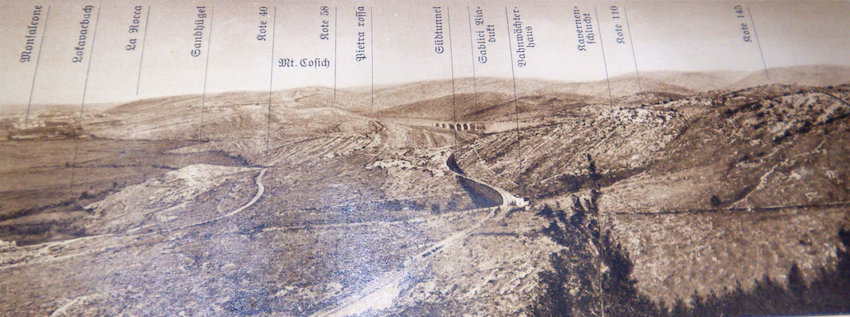
Facing the Hermada: from the war diary of Infanterieregiment Nr. 47 (K.u.K. 47)
25 May 1917, afternoon: the 10th battle of the Isonzo (LINK). Now the target of the Italians is definitively the Hermada. The greatest effort focuses on Valle di Brestovica-Brestovica pri Komnu, separating the Comeno-Komen plateau and the Isontine Karst from the stronghold on Mt. Hermada and the Triestine Karst.
The attack of Italian brigades Gaeta and Bergamo pushes the tired Austro-Hungarian troops of the 16th Division back to Klariči. Now the Italian assault overcomes the last Austro-Hungarian defense lines and climb Altitude 146, conquering it.
Driven by enthusiasm, the Italians spread around following the Austrians in retreat and, after crossing the road to Medeazza-Medja vas they reunite to the left wing of the 45th division. Some companies of the Bergamo brigade reach Altitude 175, Mr. Flondar and, right in front of them, stands “stronghold” Hermada: the “bestia indomabile” is only one kilometer away. But they’ll ever reach it. This is the deepest point of the Italian advance to Trieste.
In their ruthless, unorganized attack, Italian troops went too far, and their sides are undefended. The counterattack is immediate, quick, and efficient. And, once again, it is lead by isolated Austro-Hungarian divisions that do not wait for the orders of their commanding officers, but react to the events adapting their actions to the battlefield.
Hauptmann Stanislau Wieronski, experienced Polish officer, leads three companies of the K.u.K. Infantry Regiment Nr.11, almost completely consisting in Czech soldiers to the counterattack against the Italians.
The Czechs throw hand-grenades, surprising the infantry of the Bergamo brigade, who retreat immediately, leaving Altitude 175 behind. Wieronski does not allow them rest, and with his troops runs after the Italians, who are reaching Altitude 145. With his three companies, now reduced to only 240 men, Hauptmann Wieronski crushed an Italian regiment, turning the outcome of the battle around.
Now also the other Austro-Hungarian regiments reorganize themselves and join the counterattack: they are the surviving infantry of the 4th Battalion of K.u.K. I.R. 77 and of the 1st Battalion of K.u.K. I.R. 62. The Italians are forced to return behind the defense line of the Flondar: the first attack to the Hermada ends in a bloodbath.
Translated from blog “Ambiente e Legalità” – “Environment and Legality” by Roberto Giurastante
